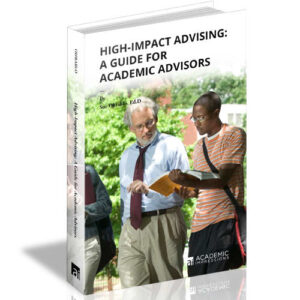
READ THE WHOLE SERIES:
Developing a High-Performing and Productive Advising Department
- Assessing and Meeting Student Needs
- Assessing and Meeting Employee Needs
- Optimizing Your Use of Student Information Systems
- Academic Advising’s Role in Change Implementation
In this series, “Developing a High-Performing and Productive Advising Department,” I’ve discussed s
trategies for identifying, assessing, and meeting student, staff, and advisors’ needs.
Now I will discuss strategies for positively impacting departmental, college, and university-wide systems and contributing to the effective implementation of change.
Be a Voice in Decision Making
Institutions vary as to how they deliver academic advising and where the function resides. Sometimes it is housed in student affairs, sometimes in academic affairs within colleges and departments, and other times there is a cross-over or shared responsibility between academic and student affairs. No matter where advising is situated, academic advising is just one small part of a larger unit. If advising is housed within student affairs, there is a challenge contributing to academic decision-making, as the role of the advising department is often thought to be limited to implementing and communicating academic decisions to students. Even when the academic advising unit is located within academic affairs, there is a risk of being considered a limited support service role and thus being excluded from decision-making and change implementation.
Let’s examine the implementation of a new curriculum as an example. Typically, institutions will regularly review curriculum on a cyclical basis. Factors such as currency of content, industry needs, employment trends, and enrollment management strategies might all contribute to the desire to revise curriculum, or add or remove program offerings. Academic advising administrators can fulfill a critical role in the change process. Below I’ve outlined the way that faculty approach change implementation and how advising administrators can contribute to its success:
| Faculty Action Items | Contributions from Academic Advising |
| Create new program based on market trends |
|
| Develop new courses |
|
| Develop course names, prefixes, prerequisites |
|
| Decide when to roll out program |
|
Engage in Intentional Problem Solving
Students, staff, advisors, faculty, and university administrators all rely on an effective academic advising unit to support the institution’s mission of educating and supporting its students. In order to establish and maintain an effective unit, you need to continuously scan the environment for observed and potential obstacles as well as look for ways to improve processes to maximize success. Some strategies administrators can use are outlined below.
1. Analyze and Ask Why
To successfully implement change, a leader must critically assess policies, processes and procedures in order to understand the origins and intended outcomes and identify any potential obstacles or limitations. By asking “why” something is done a certain way, others are forced to articulate the original rationale involved with establishing the policy or protocol, as well as reflect on the need to continue doing it that way. Questions that will get to the “why” include:
- “What is preventing us from…?”
- “Can you help me to understand how this works in connection with…?”
- “Why can’t we…?”
- “Is there someone we could talk with who could help us identify options?”
2. Persist! Set Short and Long-Term Goals
You may find that it is difficult to implement change all at once. The institution’s size and the advising unit’s role within it may determine how long it may take to implement change or how many layers of approval or consensus must be navigated in order to achieve a desired outcome. Be prepared to set a series of short and long term goals in order to make continued progress toward change. While I encourage proactive goal-setting, there is value in reactive re-setting of goals in the face of adversity and seemingly insurmountable obstacles. It is the role of the advising administrator to keep focused on the objective of meeting student needs while maximizing the effectiveness of staff without jeopardizing the well-being of either.
- What can we do right now to improve the situation or reduce the problem?
- What resources and personnel can assist in addressing this problem right now?
- What resources and personnel can assist in addressing this problem within the semester?
- What resources and personnel need to be consulted to achieve a long-term solution?
- What needs to be done to achieve a long-term solution?
An example of short and long term goal setting can be found in the following scenario.
Change Implementation Scenario
An academic program required students to enroll in a one-week, final capstone course at the end of their program. The college required students to declare their intention to register for the course up to 9 months in advance. Advisors were required to keep track of these intentions, monitor students’ progress for 3 semesters prior to registration to determine eligibility, and ultimately register students. Inevitably, students’ plans changed due to academic or personal conflicts, and advisors missed students who were eligible to participate and neglected to register them. Both students and advisors continually complained that the process was cumbersome, time consuming, and inefficient.
The advising administrator wanted to move toward student self-registration in the capstone course, but found resistance from personnel who had created the original system as well as logistical problems in allowing students to register.
Below is an outline of short and long term solutions which took approximately 3 years to implement:
- What can we do right now to improve the situation or reduce the problem?
- Help student to develop an academic plan to identify the semester in which they will enroll in capstone.
- What resources and personnel can assist in addressing this problem right now?
- Create a central repository for capstone date requests (ex. Excel document on shared drive).
- What resources and personnel can assist in addressing this problem within the semester?
- Identify options for using student information system to waitlist students.
- Train advisors on use of waitlist feature.
- What resources and personnel need to be consulted to achieve a long-term solution?
- Meet with program director, advisors, faculty to identify options for long-term problem resolution.
- Consult with registrar to identify options and possible barriers to self-registration.
- What needs to be done to achieve a long-term solution?
- Consult with registrar to set up system that will allow for registration in multiple capstones throughout the semester.
- Communicate with students about transitioning to new system.
Summary
By asking the critical questions and developing the capacity to think both short- and long-term, advising administrators can positively contribute to the success of their constituents and the institution as a whole.
Here are some final tips for achieving success:
- Look for alternative ways to achieve outcomes.
- Develop short and long term solutions.
- Challenge assertions and assumptions.
- Ask detailed questions.
- Use multiple resources.
- Show interest – be engaged.
- Develop understanding of all areas. A little bit of knowledge goes a long way.
Get Sue Ohrablo’s Book High-Impact Advising
 How can academic advisors provide high-quality developmental advising in the face of diminishing resources and increased commitments? We brought this question to Sue Ohrablo, a nationally recognized speaker with 25+ years of experience working with diverse institutions and student populations. In this 300-page, comprehensive training guide, Sue offers practical guidelines for academic advisors.
How can academic advisors provide high-quality developmental advising in the face of diminishing resources and increased commitments? We brought this question to Sue Ohrablo, a nationally recognized speaker with 25+ years of experience working with diverse institutions and student populations. In this 300-page, comprehensive training guide, Sue offers practical guidelines for academic advisors.
“I highly recommend that all academic advising professionals read High-Impact Advising: A Guide for Academic Advisors, as it will help them to enhance key skills needed to establish positive relationships with students, appropriately assess students’ needs, effectively teach students, and efficiently provide high quality service.”
Jacqueline T. Hollins, Assistant Vice Provost/Director of Academic Advisement, SUNY at Buffalo (UB) “As a department leader in academic advisement, I would use Sue’s book as a training resource and teaching mechanism for advisors. It allows advising professionals to understand today’s complex environment of advising students, beyond just selecting courses.”
Jake Shilts, Director, Advisement & Career Services, Miami Dade College “Advisors will reap the benefits of this well-balanced, informative guide.”
Shari Saperstein, Associate Dean, College of Undergraduate Studies, Nova Southeastern University “A student-centered, informative, and practical approach. Dr. Ohrablo presents powerful guidelines geared towards student success for 21st century academic advisors. The handbook offers indispensable information and engaging scenarios that mirror real life college instances that students experience. A key resource tool for academic advisors and higher education professionals.”
Dr. DeLaine Priest, Associate Vice President of Student Development and Enrollment Services, University of Central Florida

